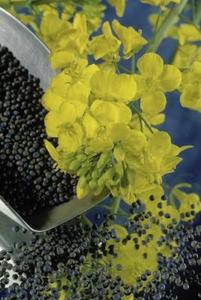
Progress on more sustainable oilseed rape
Two ENDURE partners have published details of their ongoing work on more sustainable methods for growing oilseed rape (OSR). INRA (France’s National Institute for Agricultural Research) has revealed details of its promising trials of accompanying winter rapeseed crops with legumes as a means of reducing weed pressure, while Germany’s Julius Kühn Institute (JKI) hosted an international workshop on ‘Clubroot disease in oilseed rape - status quo and research demand’ with an emphasis on integrated approaches.
INRA reports on its comparison of 79 field trials combining winter rapeseed and companion legume crops across a wide range of pedoclimatic conditions and cultivation practices in northwest France. Rapeseed and companion plants were sown together at the end of the summer, growing together during autumn until the arrival of winter frosts, which naturally killed off the legumes.
INRA reports: “During the autumn growth phase, the rapeseed and companion plants, but also weeds, competed for nutrients and light. The rapeseed was less affected by this competition when the companion plants were legumes because the latter competed less for nitrogen due to their ability to fix atmospheric nitrogen.”
At the start of winter, weed biomass was reduced by between 38% and 52% with the presence of companion plants, with no species being particularly more efficient. However, at harvest non-legume companion plants had reduced rapeseed yield (580kg/hectare lower than with rapeseed alone), while companion legumes such as field beans alone or mixed with lentils boosted yields by between 120 and 160kg/hectare. Field beans, lentils or a mix of the two also enabled nitrate inputs to be reduced by up to 25% with no significant drop in yields.
INRA concludes: “All these results showed that the cultivation of rapeseed in the presence of non-harvested companion legumes is a promising practice, particularly on nitrogen-poor soils; field bean alone or mixed with lentil displayed the best overall performance. Further studies now need to be undertaken to precisely evaluate the socioeconomic and environmental value of using companion plants, so as to prove the sustainability of this practice.”
JKI’s workshop attracted 82 delegates from nine countries and included 18 expert speakers, with the aim of sharing knowledge and integrated management techniques, identifying knowledge gaps and research needs and avoiding the duplication of work.
The sessions dedicated to integrated disease management included an examination of the potential and limitation on breeding clubroot-resistant OSR varieties and the importance of field hygiene, crop rotation and farming methods (changing sowing dates, liming etc.), plus a focus on new approaches (remote sensing, soil ecology, microorganisms etc.).
JKI reports: “Cultivar resistance is the most widely used clubroot management strategy but reliance on a single option method is not likely to be sustainable. Therefore, other strategies such as field hygiene, the sanitization of field equipments, wide crop rotation, high grade agronomical practices, weeds and volunteers control, liming and using of bait or catch crops should be taken into consideration to support the resistant cultivars.”
For more information:
Last update: 24/05/2023 - ENDURE © 2009 - Contact ENDURE - Disclaimer
